O'DAY Anita 1970
"In this world, you’ve only got what you give away", says Anita O’Day, "and that’s what I do, I give myself to my audience". For more than 50 years, the legendary jazz vocalist has shared her art, her heart, and her soul on records, in clubs and concert halls, at jazz festivals, and in a classic autobiography. The sacrifices were often painful, but they are paying off handsomely in the sixth decade of O’Day’s career.
She shooked the foundations of American popular music in 1941 as the 22-year-old "canary" fronting Gene Krupa’s big band, singing the hit "Let Me Off Uptown" with trumpeter Roy Eldridge-O’Day’s oft-repeated humble refrain has been belied by the milestones of her extraordinary life. First with Krupa, then with Stan Kenton, and finally with her own small groups, she revolutionized the art of Swing Era jazz vocalizing, providing the link between her role model, Billie Holiday, and such subsequent O'Day-influenced singers as June Christy and Chris Connor. With a set of artistic tools completely different from those of her contemporaries (Ella Fitzgerald, Peggy Lee, and Sarah Vaughan), O'Day developed a unique personal style that has earned her perennial accolades as a "pure" and "true" jazz singer.
Born in 1919 as Anita Colton, she grew up in Chicago and discovered singing as her salvation from tribulations of a harsh family and social environment during the Great Depression. As a 14-year-old, Anita entered the grueling "walkathons" of the day, earning a little extra money by singing such tunes as "The Lady in Red" and "I Can’t Give You Anything But Love". Needing to change her last name to evade the truant officer, she picked O'Day because it was pig latin for the dough she hoped to reap. Anita became a regular in Chicago saloons and nightclubs, notably at the Three Deuces, where she sang with the Max Miller Combo and frequently listened to Art Tatum.
Recruited by drummer Krupa in 1941, O'Day experienced early stardom with such hits as "Thanks for the Boogie Ride", "Georgia on My Mind", "Boogie Blues", "Skylark", "Opus One", "And That’s What You Think", and the classic "Let Me Off Uptown". The "dough" that rolled in from the records, however, amounted to the set payment of $7.50 per side.
In 1943, Anita left Krupa's band to marry professional golfer, Carl Hoff. She later joined Woody Herman's band, and afterwards, Stan Kenton's. At first, she was reluctant, because she thought her musicality wasn't compatible with Kenton's, but she did land a hit with the band in 1944 with "And Her Tears Flowed Like Wine", and topping Down Beat and Esquire magazine polls in '44 and '45. Although Anita's stay with The Stan Kenton Orchestra was short-lived, she did set the standard for future singers in the band like June Christy and Chris Connor. In fact, it was Anita who recruited Christy as her replacement. Apparently, bebop tickled Anita's ears more than swing. The rhythmic, improvisational pliancy of bebop was the perfect vehicle for Anita's singing style. Eventually she began performing with the bebop masters to sharpen her improvisational skills.
After playing the Hollywood Palladium with Woody Herman, Anita helped Gene Krupa reorganize his band and then went out on her own, affectionately known as "the Jezebel of Jazz." O'Day then recorded several sides for Signature Records and London Records. While hanging out at the Club Starlite in Los Angeles, she met drummer, John Poole. Rhythm being so essential to her musicality, she's very choosy about her drummers. In Poole, she found not just a great drummer, but a worthy musical partner for 32 years. "If the drummer is no good, I can't make it. That's why I like John Poole. He's my favorite drummer".
That led to a deal with producer Norman Granz's first labels, Norgran and Clef, which later became Verve, for whom she recorded 18 popular and critically regaled albums during a 12-year association. (In fact, with her Pablo album, O'Day has recorded for every label that Granz ever started.) From a sometimes exploited big band singer whose repertoire typically included jazz arrangements of pop songs, she became a highly paid, distinctive modernist with a sound, according to Newsweek's Charles Michener, "that plays hide-and-seek with the familiar melody so as to give it more shape, volume and thought than it's ever had before."
Still, as she always has, O'Day claims, "I'm not a singer, I'm a song stylist", and she attributes the difference to adjustments she was forced to make because of her personal physical attributes. When she was seven, during a tonsillectomy, a doctor snipped off her uvula, the fleshy gland most people have at the back of their throats, rendering her incapable of creating a natural vibrato. "I've always had to do the best I can with what I have to work with", she explains modestly, "so, like different painters who have different styles, I just have a different style. Plus, I'm kind of a tall, slim gal, and I don't have the air capacity of someone like Ella. When she takes a breath in, she can sing half a chorus. I can't do that, and that's why I don't sing ballads in tempo. I sing them telling a story, ad lib".
If anything, O'Day's ability to tell a story in song has improved over the years. As John S. Wilson wrote in the New York Times a few years ago, she is better than ever at "projecting the sense of the lyric with gentle warmth and insight, yet retaining the jazz-based character of her phrasing". Reviewing a 1989 engagement at Michael’s Pub in New York, Wilson called the then 70-year-old O’Day "the best jazz singer performing today".
In the 1960s, Anita became addicted to heroin, and nearly died from an overdose in 1967. She eventually beat her addiction, cold turkey during a retreat in Hawaii, and returned to work. In 1981, she published her autobiography, "High Times, Hard Times", which went on to become one of the great jazz autobiographies. Despite such triumphs as her 1958 appearance at the Newport Jazz Festival (documented in the film Jazz on a Summer’s Day, now on DVD) surviving to reach such a peak of form was never easy. The long road of her jazz life involved more than hit records and bus rides with the boys in the band. For O’Day it was an often harrowing journey that included back room abortions, a backstage rape, drug busts, prison time, 16 years of heroin addiction. Those experiences are long behind her now, but O'Day notes, "if you've been a junkie for 16 years, it takes you a long time to recover, and you’ve got to start all over again".
On the cover of her 1960 album Incomparable!, a young and glamorous Anita O'Day wears an iridescent shade of green eyeliner. "And I still wear it", she recently said. She's not much of a talker, she admits, but she surely is a singer. While she isn't the busiest woman in jazz, she is certainly one of the busiest 83-year-olds in jazz. In 2003, she packed the room at the Derby, a small but ritzy Los Angeles jazz club. Her dramatic life story is being developed as a feature film entitled "Nightbird". Her new record label, Kayo Stereophonic, produced in 2006 her first complete album in ten years "INDESTRUCTIBLE!", a big band affair with arrangements by Bob Kaye, where will feature chestnuts such as "Lover Come Back to Me", "I Cried For You" and "S'Wonderful".
Anita O'Day died in November 2006. In her last years, living in a comfortable retirement community, O'Day rised every morning at 4:30 am for long walks. Other times she drived around in her 1986 Buick LeSabre that, at her request, was recently painted bright gold, the windows tinted jet black. Afternoons are often spent at the racetrack, betting on her favorite horses. Ms. O'Day's vitality was even more impressive after realizing she is one of the few ladies of the classic jazz era still performing. And after her years on the road and in the studio, her firecracker personality and vocal virtuosity will still be ablaze on stage. "I just like to have a job", she explained. "Me out in the middle of the stage and a band in back of me. That's about all you can do". Her relationships to her songs (of "Body and Soul" she says, "that’s my only baby") are eclipsed only by her relationship with her audience. "Without them you’re nothing", she says. "That’s where my heart lies, that’s all I’ve got. I had a couple of boyfriends, duds, a couple of husbands, gone, but you always get something back if you give. That’s never changed".
Born in 1919 as Anita Colton, she grew up in Chicago and discovered singing as her salvation from tribulations of a harsh family and social environment during the Great Depression. As a 14-year-old, Anita entered the grueling "walkathons" of the day, earning a little extra money by singing such tunes as "The Lady in Red" and "I Can’t Give You Anything But Love". Needing to change her last name to evade the truant officer, she picked O'Day because it was pig latin for the dough she hoped to reap. Anita became a regular in Chicago saloons and nightclubs, notably at the Three Deuces, where she sang with the Max Miller Combo and frequently listened to Art Tatum.
Recruited by drummer Krupa in 1941, O'Day experienced early stardom with such hits as "Thanks for the Boogie Ride", "Georgia on My Mind", "Boogie Blues", "Skylark", "Opus One", "And That’s What You Think", and the classic "Let Me Off Uptown". The "dough" that rolled in from the records, however, amounted to the set payment of $7.50 per side.
In 1943, Anita left Krupa's band to marry professional golfer, Carl Hoff. She later joined Woody Herman's band, and afterwards, Stan Kenton's. At first, she was reluctant, because she thought her musicality wasn't compatible with Kenton's, but she did land a hit with the band in 1944 with "And Her Tears Flowed Like Wine", and topping Down Beat and Esquire magazine polls in '44 and '45. Although Anita's stay with The Stan Kenton Orchestra was short-lived, she did set the standard for future singers in the band like June Christy and Chris Connor. In fact, it was Anita who recruited Christy as her replacement. Apparently, bebop tickled Anita's ears more than swing. The rhythmic, improvisational pliancy of bebop was the perfect vehicle for Anita's singing style. Eventually she began performing with the bebop masters to sharpen her improvisational skills.
After playing the Hollywood Palladium with Woody Herman, Anita helped Gene Krupa reorganize his band and then went out on her own, affectionately known as "the Jezebel of Jazz." O'Day then recorded several sides for Signature Records and London Records. While hanging out at the Club Starlite in Los Angeles, she met drummer, John Poole. Rhythm being so essential to her musicality, she's very choosy about her drummers. In Poole, she found not just a great drummer, but a worthy musical partner for 32 years. "If the drummer is no good, I can't make it. That's why I like John Poole. He's my favorite drummer".
That led to a deal with producer Norman Granz's first labels, Norgran and Clef, which later became Verve, for whom she recorded 18 popular and critically regaled albums during a 12-year association. (In fact, with her Pablo album, O'Day has recorded for every label that Granz ever started.) From a sometimes exploited big band singer whose repertoire typically included jazz arrangements of pop songs, she became a highly paid, distinctive modernist with a sound, according to Newsweek's Charles Michener, "that plays hide-and-seek with the familiar melody so as to give it more shape, volume and thought than it's ever had before."
Still, as she always has, O'Day claims, "I'm not a singer, I'm a song stylist", and she attributes the difference to adjustments she was forced to make because of her personal physical attributes. When she was seven, during a tonsillectomy, a doctor snipped off her uvula, the fleshy gland most people have at the back of their throats, rendering her incapable of creating a natural vibrato. "I've always had to do the best I can with what I have to work with", she explains modestly, "so, like different painters who have different styles, I just have a different style. Plus, I'm kind of a tall, slim gal, and I don't have the air capacity of someone like Ella. When she takes a breath in, she can sing half a chorus. I can't do that, and that's why I don't sing ballads in tempo. I sing them telling a story, ad lib".
If anything, O'Day's ability to tell a story in song has improved over the years. As John S. Wilson wrote in the New York Times a few years ago, she is better than ever at "projecting the sense of the lyric with gentle warmth and insight, yet retaining the jazz-based character of her phrasing". Reviewing a 1989 engagement at Michael’s Pub in New York, Wilson called the then 70-year-old O’Day "the best jazz singer performing today".
In the 1960s, Anita became addicted to heroin, and nearly died from an overdose in 1967. She eventually beat her addiction, cold turkey during a retreat in Hawaii, and returned to work. In 1981, she published her autobiography, "High Times, Hard Times", which went on to become one of the great jazz autobiographies. Despite such triumphs as her 1958 appearance at the Newport Jazz Festival (documented in the film Jazz on a Summer’s Day, now on DVD) surviving to reach such a peak of form was never easy. The long road of her jazz life involved more than hit records and bus rides with the boys in the band. For O’Day it was an often harrowing journey that included back room abortions, a backstage rape, drug busts, prison time, 16 years of heroin addiction. Those experiences are long behind her now, but O'Day notes, "if you've been a junkie for 16 years, it takes you a long time to recover, and you’ve got to start all over again".
On the cover of her 1960 album Incomparable!, a young and glamorous Anita O'Day wears an iridescent shade of green eyeliner. "And I still wear it", she recently said. She's not much of a talker, she admits, but she surely is a singer. While she isn't the busiest woman in jazz, she is certainly one of the busiest 83-year-olds in jazz. In 2003, she packed the room at the Derby, a small but ritzy Los Angeles jazz club. Her dramatic life story is being developed as a feature film entitled "Nightbird". Her new record label, Kayo Stereophonic, produced in 2006 her first complete album in ten years "INDESTRUCTIBLE!", a big band affair with arrangements by Bob Kaye, where will feature chestnuts such as "Lover Come Back to Me", "I Cried For You" and "S'Wonderful".
Anita O'Day died in November 2006. In her last years, living in a comfortable retirement community, O'Day rised every morning at 4:30 am for long walks. Other times she drived around in her 1986 Buick LeSabre that, at her request, was recently painted bright gold, the windows tinted jet black. Afternoons are often spent at the racetrack, betting on her favorite horses. Ms. O'Day's vitality was even more impressive after realizing she is one of the few ladies of the classic jazz era still performing. And after her years on the road and in the studio, her firecracker personality and vocal virtuosity will still be ablaze on stage. "I just like to have a job", she explained. "Me out in the middle of the stage and a band in back of me. That's about all you can do". Her relationships to her songs (of "Body and Soul" she says, "that’s my only baby") are eclipsed only by her relationship with her audience. "Without them you’re nothing", she says. "That’s where my heart lies, that’s all I’ve got. I had a couple of boyfriends, duds, a couple of husbands, gone, but you always get something back if you give. That’s never changed".
I'm happy to share with you "Anita O'Day in Berlin" LP on MPS 21 20 750-1 produced by Joachim E. Berendt, taped at the Berlin Jazz Festival on November 7th 1970. It is Anita O'Day's first recording in seven years. She is then 50 years old, back from hell where she left her drugs habit, and still possessing the ability to swing and improvise creatively. Backed by pianist George Arvanitas, bassist Jacky Samson and drummer Charles Saudrais, O'Day is at her best on "Honeysuckle Rose", and a medley of "Yesterday" and "Yesterdays", as on "Street of Dreams". This is certainly not her best work on vinyl but it's a one not so easy to find and also the start of a second career for Anita O'Day.
ANITA O'DAY IN BERLIN LP 1970
Part 1 = Let's fall in love / Your wings / Soon it's gonna rain / Honeysucklerose / I can't get started.
Part 2 = Yesterday-Yesterdays / On a clear day / Street of dreams / Sunny.
If you want to know more , don't miss O'Day's biography "High times hard times" and also the great DVD from the 1958 Newport Jazz Festival "Jazz on a summer's day" where she sings 2 great numbers wearing a fantastic ensemble (dress and hat) black with white feathers. A must!!!
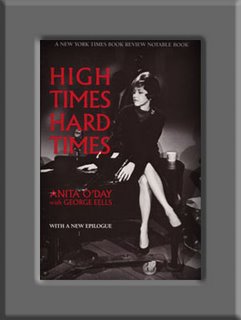

 Here is a video of 84 years old Anita O'Day singing "Honeysucklerose" and still swinging !
Here is a video of 84 years old Anita O'Day singing "Honeysucklerose" and still swinging !Download the video HERE.




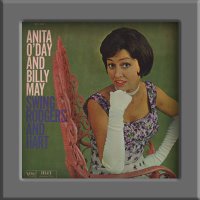
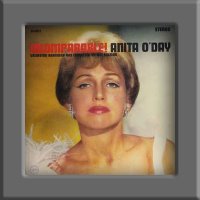



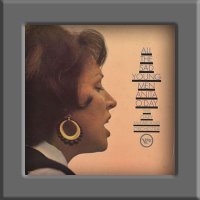
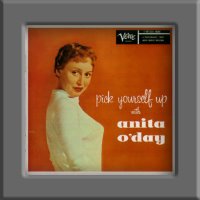



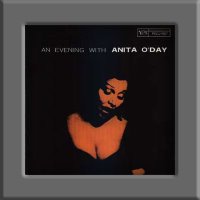


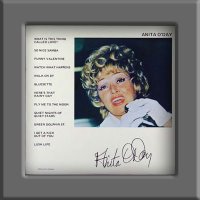



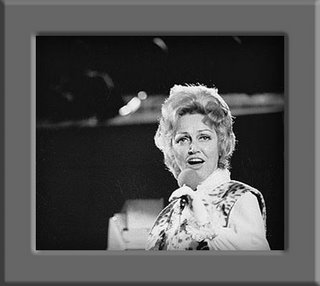
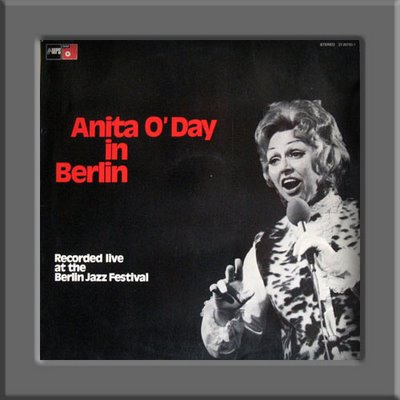



2 comments:
I LOVE this woman's voice!
Me too, she is lovely
Post a Comment